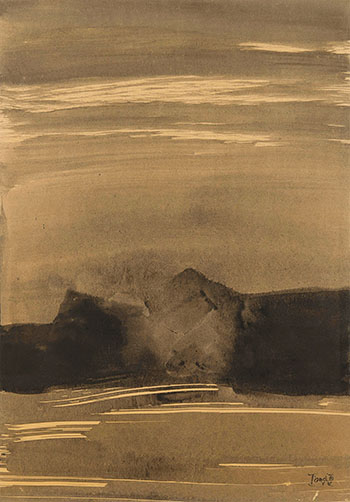Catalogue Note:
T'ang Haywen undertook in-depth study of both Taoist philosophy and traditional Chinese arts, developing an artistic sensibility characterized by both broad scope and great attention to detail; in doing so, he wrote an important page in the history of modern Chinese ink brush painting. The creation date of the present lot has been verified to be approximately 1965 by specialist of T'ang's works. A member of the third (and last) generation of Chinese artists to study in France, T'ang Haywen adopted a different approach from that of his contemporaries Chu Teh-chun and Zao Wou-ki, who were both influenced by Lin Fengmian. T'ang was basically a selftaught artist who developed his own unique style, deriving his inspiration from close observation, and deep reflection on the field of culture and the arts. As T'ang himself put it, "Art is power." The power of T'ang's art can be seen as an extension of his study of Taoist philosophy and Chinese calligraphy.
T'ang Haywen's preferred media were pastels, ink brush painting and oil painting. He enjoyed creating fusions of abstract elements from Chinese tradition with the lyrical brushwork of Western art. His main sources of inspiration were traditional Chinese calligraphy and Taoist thought. T'ang's art was characterized by vivid scenes, a powerful expressionist style, and wild, unconstrained brushwork. T'ang took Chinese ink brush painting as the foundation for his artistic creation, using it as a means for expressing his own emotions and feelings. A consistent theme in T'ang's work is the use of ink brush painting as a means of reinterpreting the detail and complexity of Chinese culture, in a manner that breaks with Chinese ink brush painting conventions. Rather than using ink brush painting to imitate nature as was the case with traditional ink brush painting, T'ang created a formalist representation of reality, an expression of pure energy and beauty.Inspired by both and Taoism by the modern masters of Western impressionist art, T'ang Haywen used ink as a medium for developing his own unique artistic style. In the integration of ink and blank space, T'ang succeeded in capturing the spirit of natural energy, while also opening up new vistas for the continued development of the ancient tradition of ink brush painting.
T'ang Haywen's preferred media were pastels, ink brush painting and oil painting. He enjoyed creating fusions of abstract elements from Chinese tradition with the lyrical brushwork of Western art. His main sources of inspiration were traditional Chinese calligraphy and Taoist thought. T'ang's art was characterized by vivid scenes, a powerful expressionist style, and wild, unconstrained brushwork. T'ang took Chinese ink brush painting as the foundation for his artistic creation, using it as a means for expressing his own emotions and feelings. A consistent theme in T'ang's work is the use of ink brush painting as a means of reinterpreting the detail and complexity of Chinese culture, in a manner that breaks with Chinese ink brush painting conventions. Rather than using ink brush painting to imitate nature as was the case with traditional ink brush painting, T'ang created a formalist representation of reality, an expression of pure energy and beauty.Inspired by both and Taoism by the modern masters of Western impressionist art, T'ang Haywen used ink as a medium for developing his own unique artistic style. In the integration of ink and blank space, T'ang succeeded in capturing the spirit of natural energy, while also opening up new vistas for the continued development of the ancient tradition of ink brush painting.
